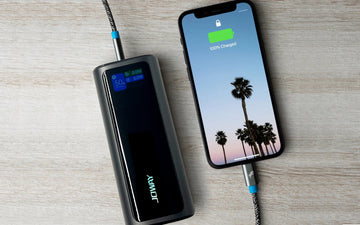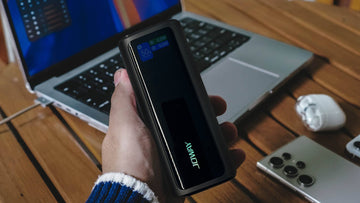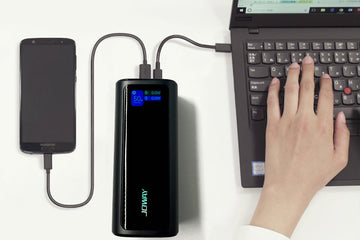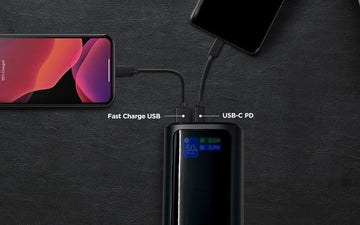
How to Choose a Good Power Bank: The Ultimate Guide
by leekelly on Aug 26, 2023
In today’s fast-paced world, keeping your devices charged while on the go is more important than ever. Whether you're a traveler, student, or professional, having a reliable power bank can make all the difference. But with so many options on the market, how do you choose the best one for your needs? This comprehensive guide will walk you through the process of selecting the perfect power bank, ensuring that your devices stay powered up wherever you are.
What is a Power Bank?
Before diving into how to choose a good power bank, it’s essential to understand what it is. A power bank is a portable device that stores electrical energy, which you can use to charge your gadgets when you don’t have access to an outlet. Power banks come in various sizes, capacities, and features, making it crucial to know your specific needs before making a purchase.
Key Factors to Consider When Choosing a Power Bank
-
Capacity (mAh)
The capacity of a power bank is one of the most important factors to consider. Capacity is measured in milliampere-hours (mAh), which indicates how much energy the power bank can store. The higher the mAh rating, the more power it can hold, allowing you to charge your devices multiple times.
-
For Smartphones: A typical smartphone battery ranges between 2,000mAh to 5,000mAh. A power bank with a capacity of 10,000mAh should provide at least two full charges for most modern smartphones.
-
For Tablets: Tablets generally have larger batteries, ranging from 5,000mAh to 12,000mAh. For these devices, you should aim for a power bank with at least 15,000mAh to 20,000mAh.
-
For Laptops: Some high-capacity power banks are designed for laptops, offering a capacity of 20,000mAh to 30,000mAh or more.
-
-
Output Power (Wattage)
The output power of a power bank is another crucial factor. It determines how fast your devices can charge. Output power is usually measured in watts (W) or amperes (A). Most modern power banks have at least 5V/2A output, which can charge a phone at a decent speed. However, for quicker charging, look for power banks that support higher outputs, such as 18W, 30W, or even 60W for laptops.
-
Fast Charging: Fast charging technology such as Qualcomm Quick Charge (QC) or USB Power Delivery (PD) can significantly reduce charging time. If you need to charge your devices quickly, make sure your power bank supports one of these technologies.
-
-
Size and Weight
Portability is one of the main reasons people choose power banks. However, there’s always a trade-off between capacity and portability. High-capacity power banks are usually larger and heavier, making them less convenient to carry around. If you need a power bank that can charge multiple devices throughout the day, you may need to compromise on size and weight.
-
Compact Power Banks: If portability is your primary concern, opt for a compact power bank that fits easily in your pocket or bag. These typically range between 5,000mAh to 10,000mAh.
-
Heavy-Duty Power Banks: For those who need extended battery life for multiple devices or larger gadgets, heavier power banks with 20,000mAh or higher may be more suitable.
-
-
Number of Ports
The number of charging ports on a power bank is another factor to consider, especially if you need to charge multiple devices at once. Some power banks come with just one USB port, while others offer multiple ports (e.g., two or three). Ensure that the power bank you choose has enough ports for your needs.
-
USB-A vs. USB-C: USB-A is the traditional USB port found on most devices, while USB-C is the newer, faster charging standard used by many smartphones, laptops, and other devices. For faster charging, look for a power bank with a USB-C port. If you use older devices, make sure it also has a USB-A port for compatibility.
-
-
Charging Speed (Input and Output)
The speed at which a power bank charges itself and charges other devices can make a significant difference, especially if you’re in a hurry. Look for power banks with fast input charging speeds (e.g., 18W or higher), as this will allow the power bank to recharge faster.
-
Input Charging Speed: A fast charging power bank will recharge in a few hours, while slower models may take much longer.
-
Output Charging Speed: For devices that support fast charging, such as smartphones with Qualcomm Quick Charge, you should look for a power bank that offers a fast output (e.g., 18W or 30W).
-
-
Durability
The durability of a power bank can be essential, especially if you plan on using it in harsh conditions. Some power banks are designed with rugged exteriors to withstand drops, dust, and water. If you’re an outdoor enthusiast, consider investing in a waterproof or shockproof power bank that can endure rough conditions.
-
Brand Reputation and Warranty
It’s always a good idea to choose a power bank from a reputable brand, as they are more likely to provide quality products and customer service. Leading brands in the power bank industry include Anker, RAVPower, Aukey, and Mophie.
-
Warranty: Look for a power bank with a warranty that covers potential defects. Most reputable brands offer warranties ranging from 1 to 2 years.
-
-
Battery Type: Lithium-Ion vs. Lithium-Polymer
Power banks typically use either lithium-ion (Li-ion) or lithium-polymer (Li-poly) batteries. While both types offer reliable performance, they have some differences:
-
Lithium-Ion Batteries: These are more common and usually less expensive. They are known for providing a higher energy density, meaning they can store more power in a smaller form factor.
-
Lithium-Polymer Batteries: These are thinner and lighter than lithium-ion batteries, but they may offer slightly less energy density. However, they are generally safer and more durable.
-
-
Price
Price is always a factor to consider when making a purchase. Power banks come in a wide range of prices depending on their features and capacity. While it’s tempting to opt for the cheapest option, it’s important to remember that a higher price usually correlates with better quality, faster charging, and more features. Aim for a balance between price and functionality to get the best value for your money.
Conclusion: Finding the Best Power Bank for Your Needs
Choosing the right power bank depends on your individual needs and preferences. By considering factors such as capacity, output power, portability, durability, and brand reputation, you can find a power bank that will keep your devices charged and ready to go whenever you need them. Whether you're looking for a compact, lightweight model or a high-capacity power bank for extended charging, there’s a perfect option out there for you.
In summary, here are the key takeaways:
-
Capacity: Choose a power bank with a high enough mAh rating for your devices.
-
Output Power: Opt for fast charging technology if you’re looking to reduce charging times.
-
Portability: Balance between size and capacity based on your needs.
-
Durability: Consider rugged designs for outdoor use.
-
Warranty and Brand: Stick with reputable brands that offer reliable customer support and warranties.
By following this guide, you’ll be able to make an informed decision and choose the best power bank for your lifestyle. Whether you’re charging your smartphone, tablet, or laptop, the right power bank will ensure you’re always connected, no matter where you are.




